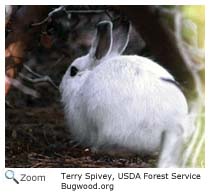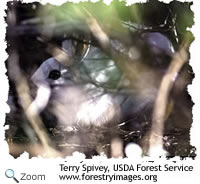Snowshoe Hare - Lepus americanus |
|||||||||
Description
RangeThe snowshoe hare is found throughout Canada and the northern United States south to northern California, northern New Mexico, northern Minnesota, northern Michigan, and northern New Jersey. Habitat
The snowshoe hare is found
in open fields, fence rows, swamps, riverside thickets, cedar bogs and coniferous lowlands. | DietThe snowshoe hare eats a variety of plants and plant matter. In the summer, it eats grasses, clover, dandelions, willow, and berries. In the winter, it eats tree buds, twigs, bark, and even carrion. Life CycleSnowshoe hares mate from March through August. The female gives birth a little over a month after mating. She two to eight babies in a nest of matted down grasses. The babies are fur-covered at birth and their eyes are open. They can run shortly after they are born. The female cares for the young until they are fully weaned at four week old. Females may have as many as four litters a year. Behavior
|
||||||||


